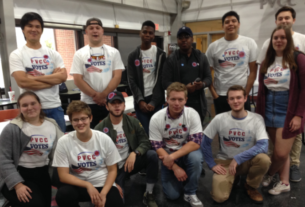PVCC works toward ‘Achieve 2015’ goals
PVCC is on its way to achieving the VCCS goals for 2015 through a “six-year strategic plan.” According to the VCCS website, VCCS is focusing on five categories to help achieve its goals: access, affordability, student success, workforce services and resources. Because PVCC is part of VCCS, PVCC has its own plan to help VCCS achieve the goal by 2015. VCCS aims to increase “the number of individuals who are educated and trained by VCCS from 50,000 to 423,000” and to “maintain tuition and fees at less than half of the comparable cost of attending” a four-year school in Virginia.
Virginia’s average of college participation and completion rate is below the average national of all community colleges in the United States. PVCC’s President Frank Friedman said the reason behind this is “the college going rate is different between urban areas, suburban areas and rural areas,” and there are “much lower college rates in South West Virginia because there is not a culture and tradition of college education.”
According to Friedman, because South West Virginia is a large part of the state, the college enrollment rate is much lower. “The most affluent and educated parts of Virginia” are Northern Virginia, Richmond, Charlottesville, and Norfolk, said Friedman.
Because the goal of VCCS for 2015 is high, it is important for PVCC to actively engage in this plan. “What has been happening in PVCC over the past five to six years is tremendous increase in enrollment. About six years ago in the fall semester, we had 4,100 students, but today we have 5,700 students,” said Friedman. To keep more PVCC students, the president said PVCC helps students through scholarships and other funding.
VCCS has the goal to “maintain tuition and fees at less than half of the comparable cost of attending” four year-schools in Virginia. The tuition and fees in community colleges are about 37 percent of four-year schools. “The goal is to keep it to no more than half. We still have room there, and we would like to keep it around in 37 percent. We do not want to keep it up to 50 percent,” Friedman said.
As for student success, there are some issues that PVCC noticed during the past years. Students are enrolling for classes, but at the end of the semester, they either drop the class or leave the class with a grade of “incomplete.”
“It is a problem all the community colleges face,” said Friedman. “We have a large number of students coming in and starting their college education,” but not trying to graduate within two years. “Over the last two years we have established what we call our Students Success Initiatives,” he added.
PVCC asked, “What can we do to help our students to complete their education at a higher rate?” Beginning next semester, the program aims to help those students who are not doing well in their classes. A peer-mentoring program is designed to choose students who are in their second years and have been getting A’s in their classes to go to the most difficult classes and tutor students who struggle with that particular subject. Friedman said, “Next semester, we are going to have about 20 classes where the tutor will be part of the class” to help students with the subject and not fail or drop the class.
Workforce Services is another large part of this goal. The plan for this department is to “double the number of employer provided training and services to 10,000,” and it is working with local businesses to train students in a specific skill. Valerie Palamountain, Dean of Workforce Services at PVCC, is happy about advancement in this field. “We have many programs, and the biggest program we have is processing the paperwork so students have clearance.” If students do not have clearance, employers will not consider hiring them. The training for this program requires 400 hours of class time.
“The area in which we have the largest students getting credentials is the basic contractor licensing. The people who remodel and build houses…must be licensed.” On top of these two big programs, there is going to be a brand new program called Small Engine Repair in addition to Workforce Services’ other programs, like healthcare.
“In 2011, we had 241 employers served,” said Palamountain. “In 2012, we had 426,” a 76.8 percent increase. Palamountain said three factors increased this number. “[We are] offering more classes, [and] we had to get involved in the student needs. We [also] improved our record keeping.”
The most popular field of study at PVCC is healthcare. According to the data, 97 percent of the students are coming back after learning one skill, and there is more room for these kinds of students. She added, “Students start with very simple skills, for example, CPR. When they find what else we can do, they come back, and we offer them training with something else.” Each of the programs are related to what companies want, so that PVCC can put a class together to get people ready for that particular job. “It is not something unusual,” said Palamountain. “We get the call, put the class together, and let it go.”





